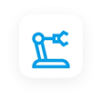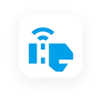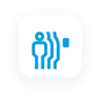From industrial Automated Guided Vehicles (AGVs) and autonomous mobile robots to IoT-powered agricultural vehicles, sensors play a vital role in different innovations happening across industries today. LiDAR is one such sensor that can detect, scan, and measure objects covering large areas, allowing autonomous systems to operate efficiently in the given environment.
Let’s find out how this technology works and its useful applications across different industrial verticals requiring automation capabilities in their day-to-day operations.
What is LiDAR Technology?
LiDAR stands for Light Detection and Ranging. This remote sensing method senses pulse light bouncing off objects and surfaces to measure distances and dimensions. Major components in a LiDAR sensor include:
• A laser source that throws laser pulses
• A scanner to deflect the light falling on the scene
• A photodetector that collects the reflected light
There are also supportive components such as optical lenses in the sensor that ensure efficient data collection.
Types of LiDAR Sensors
While the core principle behind this technology remains the same, there are several types of LiDAR sensors available that vary slightly according to their features and capabilities.
At a high level, LiDAR systems are divided into:
Airborne LiDAR
These types of LiDAR systems find applications in the aeronautics and aerospace sectors. As the name indicates, airborne LiDAR emits light towards the ground surface from the air. This system is installed in helicopters, drones, planes to map the ground surface and measure distance. Airborne LiDAR is either topological or bathymetric. Topological LiDARs map the topography of a region, while bathymetric LiDAR systems help measure the depth of water bodies.
Terrestrial LiDAR
Unlike Airborne LiDAR, terrestrial LiDARs are installed on vehicles or tripods on the ground surface. These systems can scan objects in different directions by collecting data points or point clouds to identify objects accurately. Terrestrial LiDARs can be further classified into static LiDAR and mobile LiDAR. As evident from their names, static LiDARs are capable of scanning from a fixed location. Whereas mobile LiDARs collect data points while in motion. Mobile LiDAR can collect millions of data points per minute and finds application in modern mapping and autonomous driving solutions.
The mobile LiDAR sensors available today are either mechanical or solid-state. Mechanical LiDARs collect data over a wide area by physically rotating a laser or through a rotating mirror to deflect the light beam. This motorized scanning system offers high-quality, detailed mapping of the environment and has been a reliable remote sensing technology for several years. Solid-state LiDAR sensors do not employ gears and motors to steer the laser in different directions. Instead, these sensors use semiconductor technology.
Robust LiDAR Solutions from Hokuyo
Here are some of the latest LiDAR sensors from Hokuyo that you can choose from according to your specific application.
UST-30LX
This compact and lightweight 2D LiDAR sensor provides 270° field-of-view up to 30 meters. It comes with an Ethernet interface, IP67 protection, and multi-echo integration for reliable object detection and environmental mapping, even in extreme weather conditions and unstructured environments. UST-30LX is ideal for outdoor robotic applications requiring obstacle detection and localization. The sensor is also helpful in controlling and monitoring manufacturing environments. Some of the notable applications of this LiDAR sensor include:
• Material handling, packaging, distribution, and warehousing using Autonomous Mobile Robots (AMR)
• Area mapping, surveying, and inspection with Unmanned Aerial Vehicles (UAV)
• Accurate navigation and collision avoidance in Automated Guided Vehicles and Carts (AGV, AGC)
UGM-50LAP
This outdoor-rated 2D LiDAR sensor allows you to configure three area output zones and capture distance data within the set fields. The sensor comes with an Ethernet interface and provides 190° field-of-view up to 120 meters. UGM-50LAP features IP67 shock-resistant aluminum housing and a built-in heater, enabling accurate object detection and profile measurement even in challenging environmental conditions. This robust LiDAR sensor is ideal for both indoor and outdoor applications such as:
• Geological data capturing for efficient and safe surface and underground mining
• Obstacle detection on AMRs and agricultural vehicles
• Guided navigation for the safe operation of industrial AGVs
• Port and crane automation for safe container handling
• Safe material handling with overhead and gantry cranes
• Obstacle detection and profile measurement in steel and casting production
URM-40LC-EWT
URM-40LC-EWT is a hybrid, outdoor-rated, 2D LiDAR sensor that you can configure for distance data output or are configuration. The sensor offers 270° field-of-view up to 40 meters and is equipped with an Ethernet interface. Like UGM-50LAP, this robust sensor comes with IP67 protection and multi-echo integration, ensuring accurate object detection and environmental mapping in all weather conditions. URM-40LC-EWT can be used in a range of outdoor robotics applications, including:
• Obstacle detection and localization on autonomous mobile robots (AMR) and agricultural vehicles
• Efficient material handling in industries through overhead and gantry cranes
• Automated container handling in ports
• Surface or underground mining area mapping and profile measurement
Need more assistance in selecting the suitable LiDAR sensor for your application? Reach out to us today to learn more about how our range of sensors can meet your unique business requirements.

 Factory Automation
Factory Automation Logistics Automation
Logistics Automation Process Automation
Process Automation Crane Collision Avoidance
Crane Collision Avoidance LiDAR/Obstacle Detection
LiDAR/Obstacle Detection Safety Laser Scanners
Safety Laser Scanners Optical Data Transmission
Optical Data Transmission Hot Metal Detectors
Hot Metal Detectors Laser Distance Sensor
Laser Distance Sensor Blog
Blog Whitepapers
Whitepapers Case Studies
Case Studies Infographics
Infographics